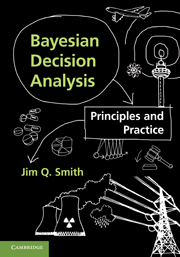Book contents
2 - Explanations of processes and trees
from Part I - Foundations of Decision Modelling
Published online by Cambridge University Press: 05 June 2012
Summary
Introduction
Some simple decision problems can be transparently solved using only descriptors like a decision table and some supplementary simple belief structure like naive Bayes model. However for most moderately sized problems the analyst will often discover that the explanation of the underlying process, the consequences and the space of possible decisions in a problem has a rich and sometimes complex structure. Whilst it is possible to follow an EMV strategy in such domains, the elicitation of the description of the whole decision problem is more hazardous. The challenge is therefore to have ways of encapsulating the problem that are transparent enough for DM, domain experts and auditors to check the faithfulness of the description of a problem but which can also be used as a framework for the calculations the DM needs to make to discover good and defensible policies.
One of the most established encompassing frameworks is a picture called a decision tree depicting, in an unambiguous way, an explanation of how events might unfold. Over the years historic trees have been used to convey the sorts of causal relationships which populate many scientific and social theories and hypotheses. These hypotheses about what might happen – represented by the root to leaf paths of the tree – describe graphically how one situation might lead to another and are often intrinsic to a DM's understanding of how she might influence events advantageously.
- Type
- Chapter
- Information
- Bayesian Decision AnalysisPrinciples and Practice, pp. 28 - 61Publisher: Cambridge University PressPrint publication year: 2010



